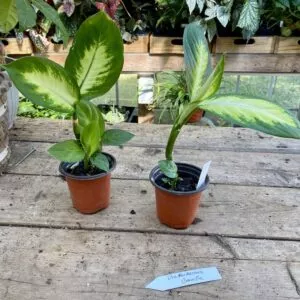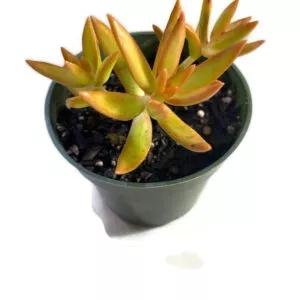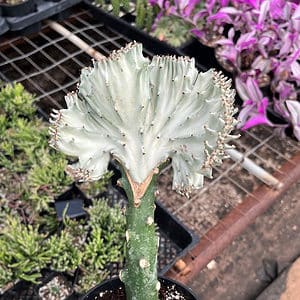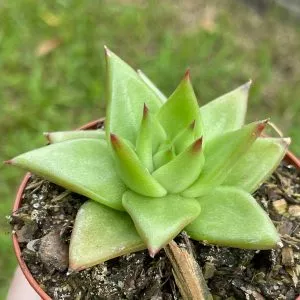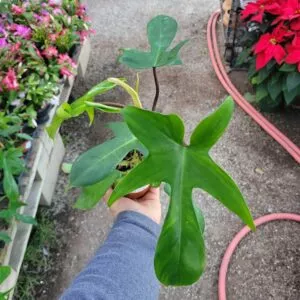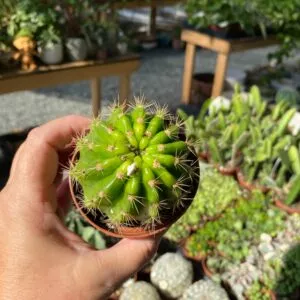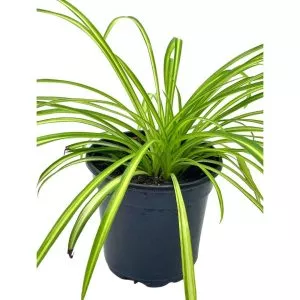No products in the cart.
Table of Contents
The Calathea zebrina ( Marantaceae family ) is an exotic plant famous for its striped foliage, which resembles the zebra. Like its cousin, the prayer plant, the zebra leaves a bright green with dark stripes. Yet, the foliage color is not the only common thing these tropical plants have, as they raise and fold their leaves at night.
The Calathea zebrina can reach up to three feet tall, and the leaves are two feet long.
Calathea Zebrina Plant Care
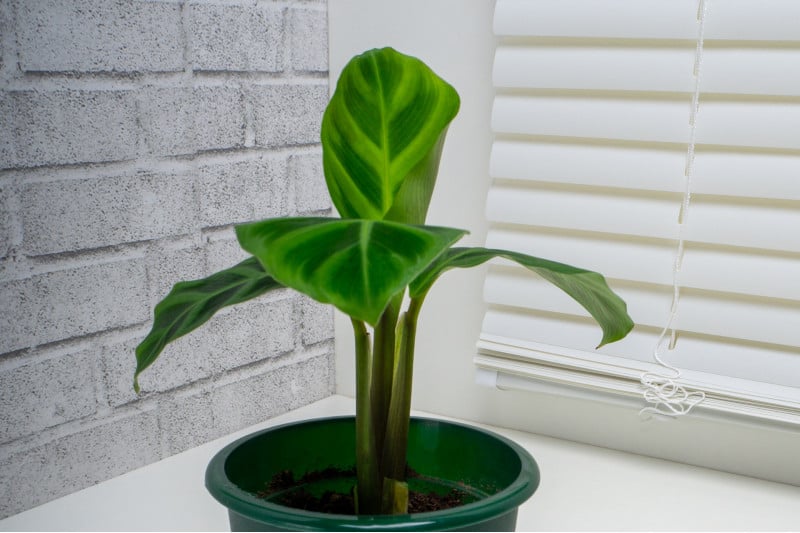
- Use well-draining soil that is loamy when potting your plant.
- Please place it in a spot with bright, indirect light.
- Water when you feel the top two inches of the soil dry.
- Only fertilizer when you notice stunted growth.
Zebra Plant Care Guide Table
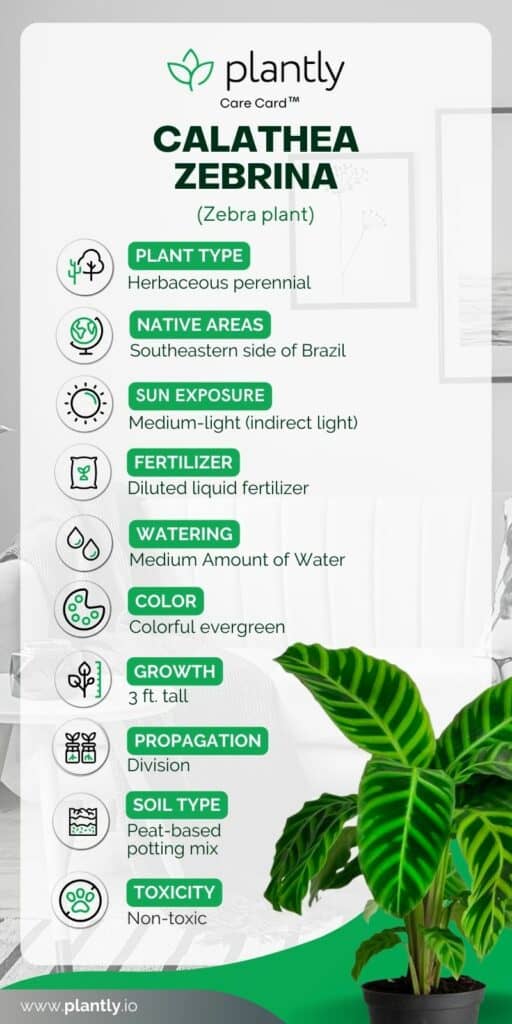
Soil for Zebra Plant

Provides Calathea zebrina with moist, well-draining soil. It helps balance well-draining and moisture as heavy wet soil leads to root rot. At the same time, soil that drains too fast will not provide enough moisture for your plant. Use potting soil mixed with peat and perlite.
Watering Zebra Plant
The zebra plant needs water frequently; how often you do this depends on how fast the soil dries out. It also changes depending on the season, humidity levels, and climate. The rule of thumb is to water your houseplant once a week in the growing season and less in winter.
The best is to feel the soil if the top inch or two is dry before watering.
-
$12.00Sold By: Smoot's Farm
In stock
Dieffenbachia or Dumb Cane Plant Camille 4 Inch Pot
Rated 4.89 out of 5 based on 27 customer ratings00Sold By: Smoot's Farm -
$4.75Sold By: Cacti and Exotica
In stock
Parodia leninghausii
Rated 4.98 out of 5 based on 59 customer ratings00Sold By: Cacti and Exotica -
$12.99Sold By: BubbleBlooms
In stock
Watermelon Pilea Cadierei, Aluminum Plant, 4 inch
Rated 4.81 out of 5 based on 279 customer ratings00Sold By: BubbleBlooms -
$12.95Sold By: Orchid Stuff Plus
In stock
Sedum Adolphii ‘Firestorm’ Succulent in a 4 inch pot!
Rated 5.00 out of 5 based on 1 customer rating00Sold By: Orchid Stuff Plus
Light
The Calathea zebrina you find native to South America grows under tree canopies for protection. Hence, it is used to receive dappled light. So, it is best to keep this in mind growing indoors.
Please place it in bright, indirect light to prevent leaf burn. For outdoor plants, please place them in a spot to receive partial sunlight.
Temperature and Humidity

The humidity level should be around 60 percent to maintain a healthy zebra plant. You can quickly achieve this in the tropical climate outdoors in the USDA growing zones 10 to 11.
For your indoor Calathea zebrina, it helps to place a humidifier to help increase the moisture or place it on a pebble tray with water. Also, mist the foliage a few times a week.
Like most Calatheas in the genus, it does best in high temperatures between 65 and 75 degrees Fahrenheit. Prevent temperatures from dropping below 50 degrees Fahrenheit.
Fertilizer
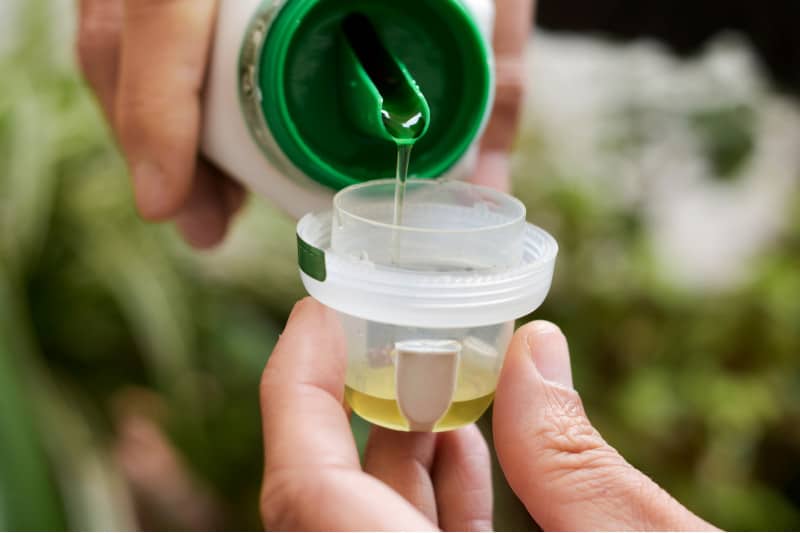
Calathea zebrina does not need fertilizer, as too much can burn the plant roots. Still, if your plant looks weak or slow-growing, you can fertilize your zebrina plant with a well-balanced fertilizer. Dilute it to a quarter strength.
Potting and Repotting Calathea Zebrina
The zebra plant is a slow grower, and you only need to repot every two years. When you notice your plant becoming rootbound with the roots poking out the drainage holes, it is time to give it a new home.
Choose a container that is about two inches larger with a lot of drainage holes. Tip the plant on the side and out the pot. Place your plant in fresh soil at the same level as the previous container.
How to Propagate Calathea Zebrina
The best way to propagate Calathea zebrina is through division. You can do this when the mother plant produces separate rosettes at the base of the plant.
Invest in a pot with enough drainage holes, fill it with well-draining soil, and use a sharp knife following these directions:
- Fill the container with the soil and slide your plant out of the pot to remove the excess dirt.
- Separate the leaves forming rosettes at the base and take the knife to cut the root system.
- Place each division in separate pots, leaving the leaves to rest on top at the soil level. Cover the roots with soil and wall well, allowing excess water to drain freely.
- Place your divided plants in a spot with bright, indirect light and high humidity.
-
$29.99Sold By: Cacti and Exotica
In stock
5″ Euphorbia lactea crest grafted
Only 8 available and it’s in 3 people’s basketRated 4.98 out of 5 based on 59 customer ratings00Sold By: Cacti and Exotica -
$8.99Sold By: BubbleBlooms
In stock
Echeveria agavoides, Molded-wax Agave, in 3 inch pot, super filled
Only 50 available and it’s in 1 people’s basketRated 4.81 out of 5 based on 279 customer ratings01Sold By: BubbleBlooms -
$24.95Sold By: Orchid Stuff Plus
In stock
Golden Pathos (Epipremnum aureum) in a 6 inch pot!
Rated 5.00 out of 5 based on 1 customer rating00Sold By: Orchid Stuff Plus -
$20.00 – $40.00Sold By: Plants by Stinky Boo
In stock
Philodendron Florida Green
Only 15 available and it’s in 1 people’s basketRated 5.00 out of 5 based on 2 customer ratings00Sold By: Plants by Stinky Boo
Calathea Varieties
Yes, it only takes one look at the Calathea varieties to know what makes it a show-stopping houseplant: the foliage. Here are the different varieties you can find.
Calathea orbifolia
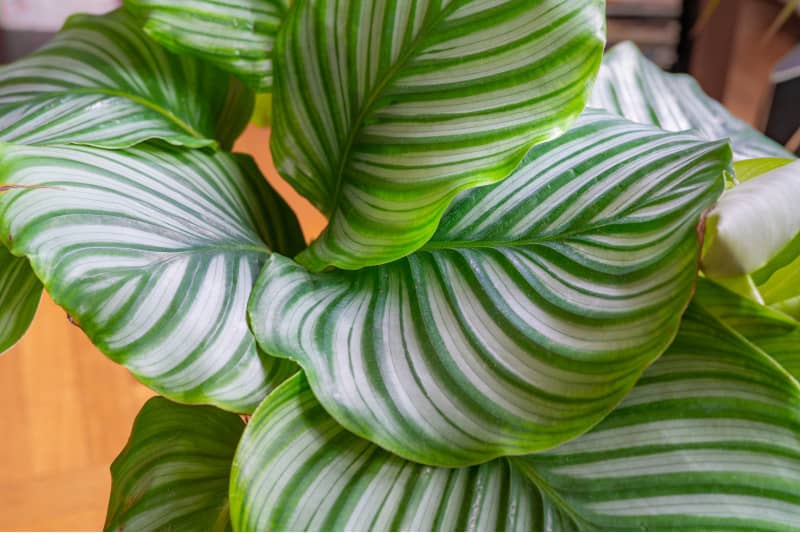
Do you want to make a bold statement? Then, the Calathea orbifolia is a show-stopper and gem for your home. It has large, robust leaves with a metallic pattern. The leaf, streaked in silver with a leathery feel, can grow up to 12 inches wide.
Calathea warscewiczii
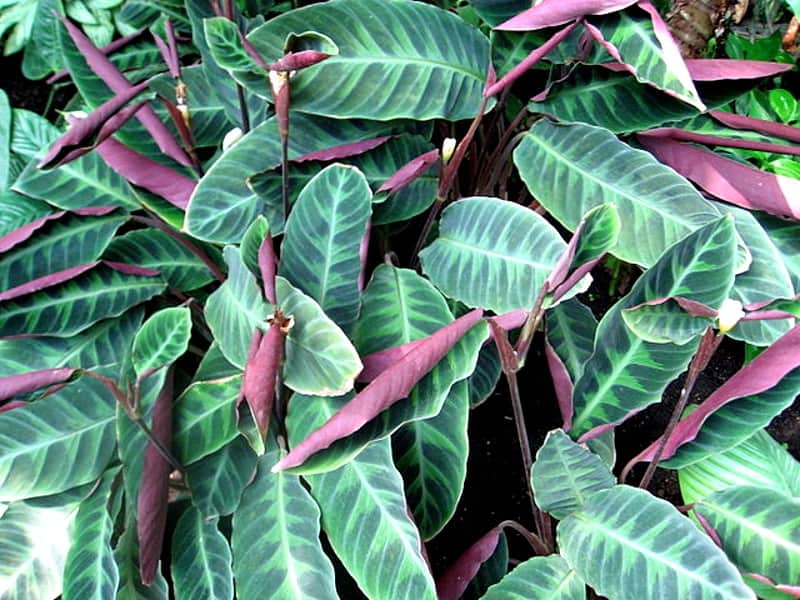
Calathea warscewiczii is native to Costa Rica and Nicaragua and looks like a fabulous indoor plant. Another name it goes by is the Calathea Jungle Velvet, which is easier to pronounce.
It has lance-shaped, velvety dark green leaves with a lighter green banding, forming a fishtail pattern. The undersides of the leaf are rich purple, and the leaf also folds close at night.
Calathea makoyana
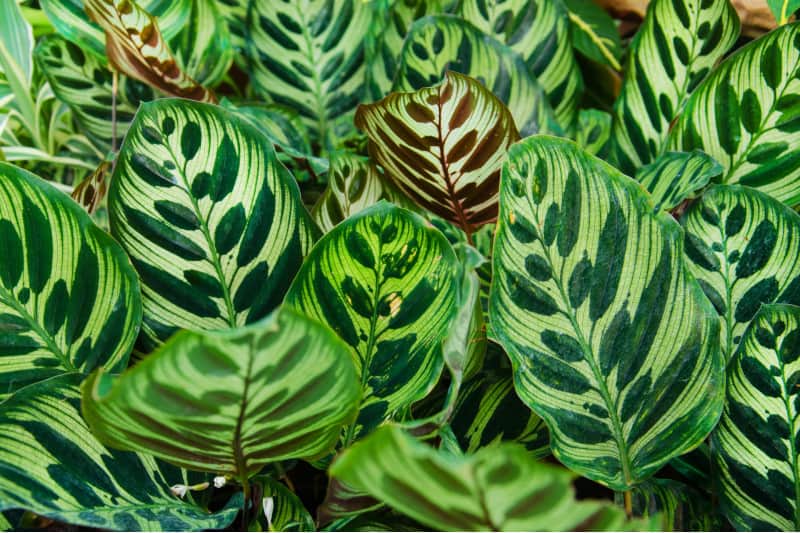
The Peacock plant, or Cathedral Window, is an elaborate plant with egg-shaped foliage. On the underside of the leaf is a purple hue and light green to dark green peacock markings. Added to your zebra plant and other Calathea exotic collections, it will blend superbly.
Calathea Zebrina Diseases & Pests
As with most plants, zebra plants can have damaged or diseased leaves you can trim off. It’s important to dust off the leaves after a few days. Please do not use any shining products.
Just use a soft, damp cloth to clean the foliage. Occasionally, you can give your plant a lukewarm shower, drying off the leaves with a cloth. Here are some other telltale signs to look out for.
Drooping Leaves:
If you notice this happening to your zebra plant, it might get too cold or be exposed to draughts. If the air turns dry, the leaves might also droop and need increased humidity. Yet, if the problem persists too long, the damage is irreversible. If you start noticing drooping leaves, you can move your plant to a warmer spot.
Yellow Leaves
It could be that your zebra plants are not getting enough water. To remove the problem, you can keep the soil moist in the growing season. Alternatively, you can place it in a self-watering container. Another concern with underwatering is if the leaves curl up.
Limp Stems
When your Calathea shows signs of limp leaves, it can be from overwatering during the winter months. Or the temperature is too low and can lead to stem rot.
Leaves Pointing Up
There is no concern if this happens as it closes its leaves at night and opens in the morning. The problem is when leaves fade due to improper lighting from too little or too much.
Another concern is gray mold that develops on the leaves. It usually happens when the humidity is highly muggy. It helps to trim back portions of leaves affected by the decay to provide ventilation.
Pests
While pests do not visit your plant Calathea, you must watch for scale, spider mites, mealybugs, and aphids. Treating spider mites helps by using insecticidal soap and keep the humidity levels at the desired level. For the other insects, you can use neem oil.
Frequently Asked Questions
Calathea zebrina, commonly known as the Zebra plant, is considered non-toxic to humans and pets such as cats and dogs. This makes it a safe choice for households with curious pets or small children.
However, while Calathea zebrina is non-toxic when ingested, it’s important to note that it may still cause mild gastrointestinal upset if consumed in large quantities.
This can lead to symptoms like drooling, vomiting, or mild stomach discomfort in pets or children. It’s best to discourage pets and children from chewing on or ingesting houseplants to avoid issues.
Yes, you can trim and remove any damaged or unsightly leaves. Regular pruning can help keep the plant looking tidy and encourage new growth. Remember that while Calathea zebrina can be a bit finicky in its care requirements, it rewards you with stunning foliage when its needs are met. Patience and attention to specific care requirements will help keep this beautiful plant healthy and thriving.
You can increase humidity by misting the plant regularly, placing it on a tray with water and pebbles, using a room humidifier, or grouping it with other plants to create a microclimate of higher humidity.
The plant grows moderately, with new leaves appearing every few weeks during the growing season. The growth rate can vary depending on environmental factors such as light, temperature, and humidity. Providing the plant with proper care and attention encourages healthy growth.
There are a few possible reasons for Calathea zebrina leaves turning brown. One common cause for brown foliage is overwatering – these plants prefer moist soil but can’t tolerate standing water. Ensure the soil is well-draining, and you’re not watering too frequently.
Another is that the plant is getting too much direct sunlight – these Calatheas prefer bright but indirect sunlight. Finally, brown leaves could indicate that the plant is experiencing low humidity. Consider using a humidifier or placing a tray of water near the plant to increase the moisture in the air.
It depends on the reason for removing the stems from your Calathea zebrina. If the stems on your zebra plant are dead or diseased, it is best to remove them to prevent the spread of the issue to the rest of the plant.
If you want to propagate your Calathea zebrina, you can remove stems and propagate them in water or soil. However, if the plant is healthy and the stems are just unsightly, it is up to personal preference whether or not to remove them.
Whether you want to buy, sell or simply reach out to other plant enthusiasts, Plantly is the right place to be!
-
$8.00Sold By: Smoot's Farm
In stock
Cactus Lemon Barrel Echinopsis Calochlora 3″ Pot Live Plant
Rated 4.89 out of 5 based on 27 customer ratings00Sold By: Smoot's Farm -
Free Shipping$19.96Sold By: CZ Grain
In stock
Bonsai Tree Kit – Grow 5 Species of Bonsai Tree w/ Our All-in-One Plant Kit: Bonsai Pots & Soil | Great Gardening Gifts for Women and Men
Only 884 available and it’s in 2 people’s basketRated 4.60 out of 5 based on 156 customer ratings01Sold By: CZ Grain -
$12.99Sold By: BubbleBlooms
In stock
Spider Plant, Chlorophytum comosum, Ribbon Plant, in a 4 inch pot, very filled
Rated 4.81 out of 5 based on 279 customer ratings00Sold By: BubbleBlooms -
$5.99Sold By: BubbleBlooms
In stock
Polka-dot-plant, Hypoestes phyllostachya, limited, in a 2 inch pot super cute
Only 895 available and it’s in 4 people’s basketRated 4.81 out of 5 based on 279 customer ratings03Sold By: BubbleBlooms
